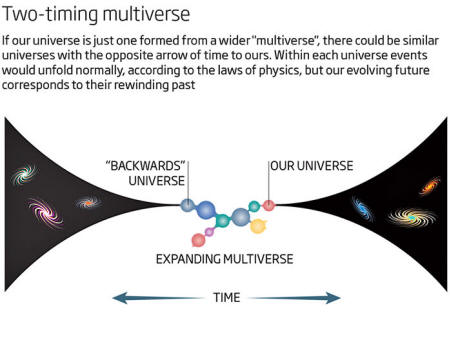|
by Joshua Sokol 13 January 2016
from
NewScientist Website
pocket universes could be born with clashing directions of time - the evolving future of one
could happen in the rewinding
past of another Don't pity those in the past - in their own way, they might have a lot to look forward to.
From our perspective, events in some universes may seem to unfold backwards. That implies there could be alternate worlds whose future is actually even further in our distant past.
This trippy idea has been suggested before, often with very specific caveats. In 2004, Sean Carroll, now at the California Institute of Technology in Pasadena, showed it could apply, but only if complex and unlikely physics was involved.
Now Carroll and cosmologist Alan Guth of the Massachusetts Institute of Technology have shown how time itself can arise organically from simpler principles, then flow in opposite directions in adjacent universes.
Guth and Carroll's work is motivated by a problem vexing physicists and philosophers:
It's true we can only remember the past (see far below "Why the Future Keeps Slipping Your Mind"), but the laws of physics don't much care which way time flows: any physical process run backwards still makes sense according to those laws.
In the absence of other laws to set the direction of time, physicists have settled on entropy - basically, a measure of messiness. As entropy grows, time ticks forward.
For example, you can stir milk into coffee but you can't stir it back out again - so neatly separated black coffee and milk always comes first.
Zooming out to the entire universe, we likewise define the future (see "Why Time Keeps Going Forwards") as that direction of time in which entropy increases.
By studying the motion of faraway galaxies, we can predict how the cosmos will evolve. Or we can rewind time back to the big bang, when the universe must have had much less entropy.
Try to rewind further and we meet a cosmological conundrum.
We can't proceed if the big bang was indeed the beginning of time, but in that case, why did it have such low entropy? And if it wasn't the beginning of time - as Guth suspects - we'd still want to know how an eternal universe could have reached such a low-entropy state that would allow for the arrow of time to form.
In an as yet unpublished model, Guth and Carroll explore the latter idea. They drop a finite cloud of particles, each zipping around with its own randomly assigned velocity, into an infinite universe.
After a while, arrows of time emerge spontaneously.
The random starting conditions mean that half the particles initially spread outwards, increasing entropy, while the other half converge on the centre, decreasing entropy, then pass through and head outwards.
Eventually the whole cloud is expanding, and entropy is rising in tandem. Crucially, this rise happens even if you reverse time by flipping the starting velocity of every particle: ultimately, all particles will end up travelling outwards.
If entropy grows either way, who's to say which way the arrow of time should point?
The model shows that an arrow of time arises spontaneously in an infinite, eternal space.
Since this allows entropy to grow without limit, time zero could simply be the moment where entropy happened to be at its lowest. That could explain why the big bang, the earliest moment we can see, has so little entropy.
But it also feels a little like a cheat: if entropy can be infinite, anything can have relatively "low" entropy by comparison.
If the model matches reality, it would have implications for more than just our own observable universe.
According to cosmic inflation - an account, pioneered by Guth, of the universe's rapid early expansion - our cosmos is just one among many (see "Multiplying Universes - How Many is the Multiverse?").
Fresh pocket universes, next to ours but far enough away as to be unreachable, spring from the vacuum all the time.
That would mean that the big bang represents the instant our universe sprang into being from the multiverse, after the arrow of time had already been set.
Parallel universes, born around the same time as ours, would have started with similar entropy to ours. If we could talk with beings there, they would agree with us on the direction of past and future.
But from our viewpoint, time would be turned on its head in universes that arose before our arrow of time was set (below image). Nobody would notice, though.
While small, random differences between these backwards universes and ours might lead to vastly different fates, living beings there would see an arrow of time, but,
It would be hard to have that argument though.
The new model has its issues.
Its initial state, when all particles are given random velocities, is fuzzy in that the diverging arrows of time are not yet clearly defined, since entropy is growing in some places while shrinking in others.
Understanding this period in between the two emergent arrows of time is hard.
It's a weakness Guth acknowledges - and along with the difficulty of incorporating elements like gravity, it's a reason why their work hasn't been published yet, he says.
"The direction of time we experience could have been set in a parent or grandparent universe"
Andreas Albrecht also isn't sold on how the model handles an infinite universe, in which entropy can just keep growing forever.
That key feature explains why the big bang had "low" entropy compared with now, but it's controversial.
He believes their use of infinite universes helps to hide big assumptions in the model.
But Albrecht likes the possibility of two arrows of time, where the multiverse's distant past is also its far future.
***
|



